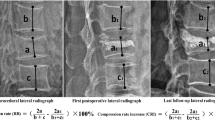Abstract
Objective
The purpose of this study was to evaluate the incidence and risk factors associated with adjacent vertebral fracture after percutaneous vertebroplasty (PVP) to treat osteoporotic vertebral compression fractures. We also investigated the effect of intradiscal cement leakage on adjacent vertebral fracture formation after PVP.
Materials and methods
From January 2003 to March 2009, 188 patients (163 women, 25 men; mean age, 70.9 years; range, 42–92 years) who underwent 214 PVP sessions at 351 levels for osteoporotic vertebral compression fractures were retrospectively enrolled in this study. The effect of intradiscal cement leakage on new adjacent vertebral fracture formation after PVP was evaluated. Possible other risk factors were also analyzed using univariate and multivariate methods. The risk factors included age, gender, mean bone mineral density (BMD), the vertebral level treated, presence of an intravertebral cleft or cyst before treatment, kyphosis angle, wedge angle, and the injected cement volumes.
Results
During the follow-up periods, new adjacent vertebral fractures developed in 36 (10.3%) of 351 treated levels. For 91 (25.9%) levels, intradiscal cement leakage was detected on procedural fluoroscopic radiographs. There was no statistically significant association between intradiscal cement leakage and new adjacent vertebral compression fracture (p = 0.789). Among the other risk factors, only the vertebral levels treated, especially the thoracolumbar junction, showed a significant relationship to new adjacent vertebral fractures (univariate analysis, p = 0.037; multivariate analysis, p = 0.043).
Conclusions
Intradiscal cement leakage does not seem to be related to subsequent adjacent vertebral compression fracture in patients who underwent PVP for treatment of an osteoporotic compression fracture. The thoracolumbar location of the initial compression fracture is the only factor correlated with an adjacent vertebral fracture after PVP.



Similar content being viewed by others
References
Kim SH, Kang HS, Choi JA, Ahn JM. Risk factors of new compression fractures in adjacent vertebrae after percutaneous vertebroplasty. Acta Radiol. 2004;45(4):440–5.
Dublin AB, Hartman J, Latchaw RE, Hald JK, Reid MH. The vertebral body fracture in osteoporosis: restoration of height using percutaneous vertebroplasty. AJNR Am J Neuroradiol. 2005;26(3):489–92.
Trout AT, Kallmes DF, Kaufmann TJ. New fractures after vertebroplasty: adjacent fractures occur significantly sooner. AJNR Am J Neuroradiol. 2006;27(1):217–23.
Lee WS, Sung KH, Jeong HT, Sung YS, Hyun YI, Choi JY, et al. Risk factors of developing new symptomatic vertebral compression fractures after percutaneous vertebroplasty in osteoporotic patients. Eur Spine J. 2006;15(12):1777–83.
Berlemann U, Ferguson SJ, Nolte LP, Heini PF. Adjacent vertebral failure after vertebroplasty. A biomechanical investigation. J Bone Joint Surg Br. 2002;84(5):748–52.
Ahn Y, Lee JH, Lee HY, Lee SH, Keem SH. Predictive factors for subsequent vertebral fracture after percutaneous vertebroplasty. J Neurosurg Spine. 2008;9(2):129–36.
Lin WC, Cheng TT, Lee YC, Wang TN, Cheng YF, Lui CC, et al. New vertebral osteoporotic compression fractures after percutaneous vertebroplasty: retrospective analysis of risk factors. J Vasc Interv Radiol. 2008;19(2 Pt 1):225–31.
Uppin AA, Hirsch JA, Centenera LV, Pfiefer BA, Pazianos AG, Choi IS. Occurrence of new vertebral body fracture after percutaneous vertebroplasty in patients with osteoporosis. Radiology. 2003;226(1):119–24.
Hiwatashi A, Ohgiya Y, Kakimoto N, Westesson PL. Cement leakage during vertebroplasty can be predicted on preoperative MRI. AJR Am J Roentgenol. 2007;188(4):1089–93.
Bartynski WS, Heller MT, Grahovac SZ, Rothfus WE, Kurs-Lasky M. Severe thoracic kyphosis in the older patient in the absence of vertebral fracture: association of extreme curve with age. AJNR Am J Neuroradiol. 2005;26(8):2077–85.
Lin EP, Ekholm S, Hiwatashi A, Westesson PL. Vertebroplasty: cement leakage into the disc increases the risk of new fracture of adjacent vertebral body. AJNR Am J Neuroradiol. 2004;25(2):175–80.
Teng MM, Wei CJ, Wei LC, Luo CB, Lirng JF, Chang FC, et al. Kyphosis correction and height restoration effects of percutaneous vertebroplasty. AJNR Am J Neuroradiol. 2003;24(9):1893–900.
Mirovsky Y, Anekstein Y, Shalmon E, Blankstein A, Peer A. Intradiscal cement leak following percutaneous vertebroplasty. Spine. 2006; 31(10):1120–1124.
Schmidt R, Cakir B, Mattes T, Wegener M, Puhl W, Richter M. Cement leakage during vertebroplasty: an underestimated problem? Eur Spine J. 2005;14(5):466–73.
Garfin SR, Yuan HA, Reiley MA. New technologies in spine: kyphoplasty and vertebroplasty for the treatment of painful osteoporotic compression fractures. Spine. 2001; 26(14):1511–1515.
Watts NB, Harris ST, Genant HK. Treatment of painful osteoporotic vertebral fractures with percutaneous vertebroplasty or kyphoplasty. Osteoporos Int. 2001;12(6):429–37.
Shapiro S, Abel T, Purvines S. Surgical removal of epidural and intradural polymethylmethacrylate extravasation complicating percutaneous vertebroplasty for an osteoporotic lumbar compression fracture. Case report. J Neurosurg. 2003;98(1 Suppl):90–2.
Syed MI, Patel NA, Jan S, Harron MS, Morar K, Shaikh A. Intradiskal extravasation with low-volume cement filling in percutaneous vertebroplasty. AJNR Am J Neuroradiol. 2005;26(9):2397–401.
Pitton MB, Herber S, Bletz C, Drees P, Morgen N, Koch U, et al. CT-guided vertebroplasty in osteoprotic vertebral fractures: incidence of secondary fractures and impact of intradiscal cement leakages during follow-up. Eur Radiol. 2008;18(1):43–50.
Peh W, Gillula L, Peck D. Percutaneous vertebroplasty for severe osteoporotic vertebral compression fractures. Radiology. 2002;223:121–6.
Ross PD, Davis JW, Epstein RS, Wasnich RD. Pre-existing fractures and bone mass predict vertebral fracture incidence in women. Ann Intern Med. 1991;114(11):919–23.
Arden NK, Griffiths GO, Hart DJ, Doyle DV, Spector TD. The association between osteoarthritis and osteoporotic fracture: the Chingford Study. Br J Rheumatol. 1996;35(12):1299–304.
Acknowledgments
This study was conducted with the Korea University Research Grant.
All authors have no financial relationships with commercial entities.
Author information
Authors and Affiliations
Corresponding author
Rights and permissions
About this article
Cite this article
Lee, KA., Hong, SJ., Lee, S. et al. Analysis of adjacent fracture after percutaneous vertebroplasty: does intradiscal cement leakage really increase the risk of adjacent vertebral fracture?. Skeletal Radiol 40, 1537–1542 (2011). https://doi.org/10.1007/s00256-011-1139-x
Received:
Revised:
Accepted:
Published:
Issue Date:
DOI: https://doi.org/10.1007/s00256-011-1139-x




